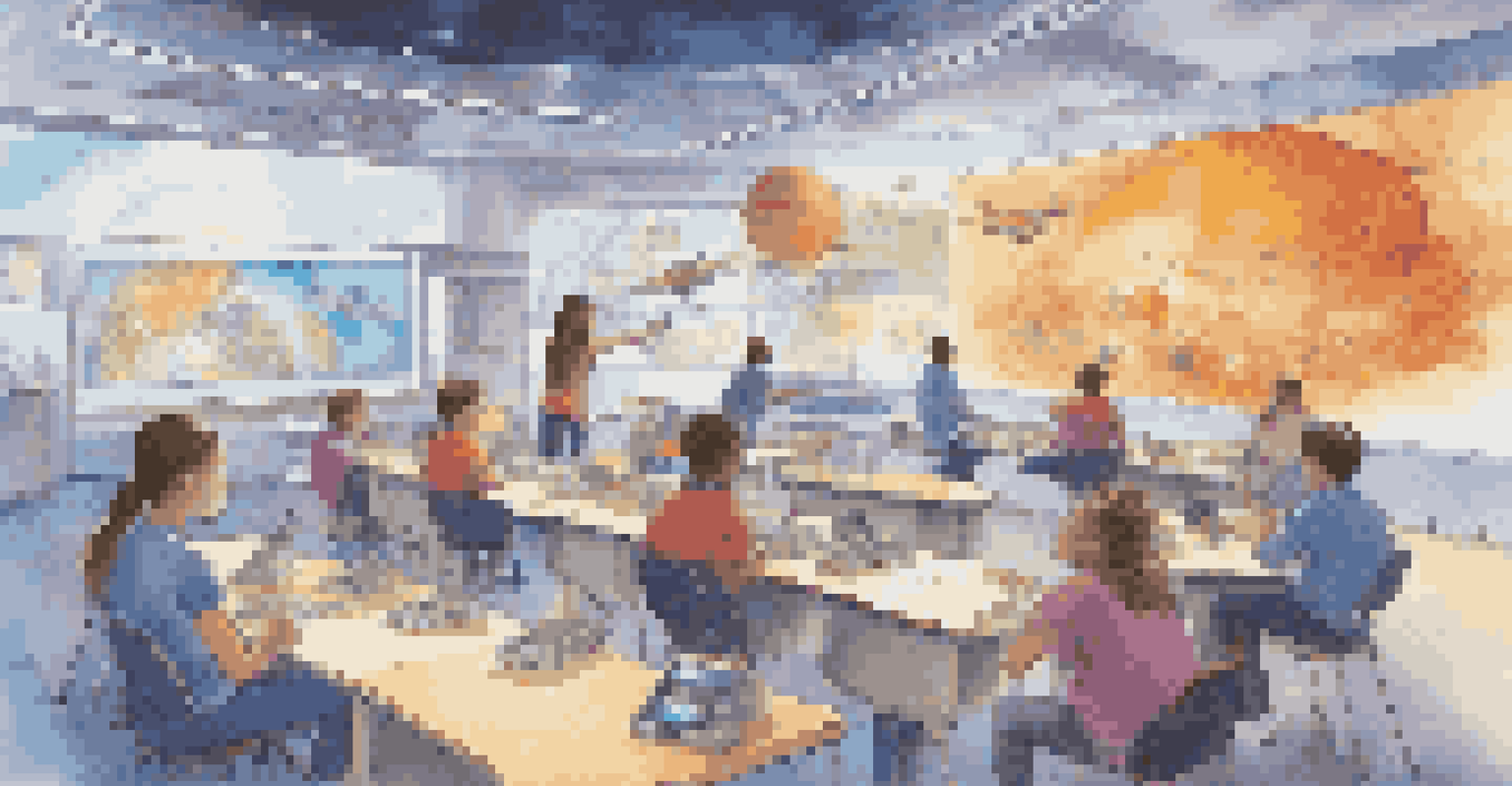The Influence of Narrative Design on Student Engagement in Class

Understanding Narrative Design in Education
Narrative design refers to the structured storytelling elements that create a cohesive and engaging learning experience. In education, it can encompass everything from curriculum frameworks to the way lessons are delivered. By weaving stories into lessons, educators can make content more relatable and memorable for students.
Stories are a communal currency of humanity.
When students encounter a narrative, they are often more invested in the learning process. This investment comes from the emotional connection that stories foster, allowing students to see themselves within the context of the material. An engaging narrative can turn a simple lesson into an adventure, making students eager to participate.
Ultimately, understanding narrative design is key for teachers seeking to enhance engagement. The combination of storytelling with educational content can lead to deeper comprehension and retention, paving the way for a more dynamic classroom environment.
The Power of Storytelling in the Classroom
Storytelling is a timeless method of communication that resonates with people of all ages. In a classroom, storytelling can transform mundane facts into captivating tales that spark curiosity. For example, instead of just teaching about historical events, a teacher might narrate the life of a historical figure, bringing their struggles and successes to life.

When students hear a story, they often become emotionally invested in the outcome, which can lead to increased participation and discussion. This engagement can also encourage students to ask questions and explore the subject matter more deeply. In this way, storytelling acts as a bridge between the teacher and students, fostering a collaborative learning atmosphere.
Narrative Design Enhances Learning
Incorporating narrative design in education fosters emotional connections, making lessons more engaging and memorable for students.
Moreover, stories can help students remember key concepts long after the lesson has ended. By associating information with a narrative, students can recall facts and ideas more easily, enhancing their overall learning experience.
Creating Relatable Characters to Boost Engagement
One effective way to enhance narrative design is through the use of relatable characters. When students see themselves reflected in characters, they are more likely to engage with the material. For instance, a math lesson that features a character facing real-world financial challenges can make abstract concepts more tangible.
Narrative is the beginning and the end of understanding.
These characters can serve as guides, leading students through the learning journey. As students follow the characters' adventures, they can learn important lessons about problem-solving and critical thinking. This approach not only makes learning enjoyable but also encourages empathy and understanding among peers.
Ultimately, relatable characters help create a sense of belonging in the classroom. When students feel connected to the characters, they are more likely to participate actively and invest in their learning experience.
Using Conflict to Drive Engagement and Learning
Conflict is a fundamental element of any good story, and it can also play a crucial role in educational narratives. By introducing challenges or dilemmas within lessons, teachers can stimulate critical thinking and problem-solving skills. For example, a science lesson might present a character facing an environmental crisis, prompting students to devise solutions.
This conflict not only keeps students engaged but also encourages collaboration as they work together to find answers. It transforms learning from a passive activity into an active pursuit, where students are invested in the outcome. As they navigate these challenges, students develop resilience and adaptability.
Relatable Characters Boost Engagement
Using relatable characters in lessons allows students to see themselves in the story, enhancing their participation and investment in learning.
Incorporating conflict into narratives allows educators to create a dynamic learning environment. Students become active participants in their education, which can lead to deeper understanding and retention of the material.
The Role of Setting in Enhancing Learning Experiences
The setting of a narrative is just as important as the characters and the plot. It provides context and can greatly influence how students perceive and engage with the material. For instance, a lesson set in a futuristic world can inspire students to think creatively about technology and its implications.
A well-crafted setting can transport students to different times and places, igniting their imaginations and curiosity. This immersive experience helps to maintain their attention and encourages them to explore the subject matter further. The more vivid and detailed the setting, the more likely students are to remember the lessons learned.
Creating unique settings within educational narratives can also foster a sense of adventure and exploration. When students feel like they are part of a larger story, they are more likely to take risks and engage in discussions, enriching the overall classroom experience.
Feedback Loops: Engaging Students Through Reflection
Incorporating feedback loops into narrative design can significantly enhance student engagement. After completing a narrative-driven lesson, allowing students to reflect on their experiences helps solidify their learning. This reflection can take the form of discussions, journaling, or creative projects that connect back to the narrative.
By encouraging students to share their thoughts and feelings about the story, teachers can gain valuable insights into their understanding and perspectives. This feedback not only enriches the learning environment but also fosters a sense of community among students. They learn from each other's experiences, deepening their connection to the material.
Conflict Drives Critical Thinking
Introducing conflict within educational narratives encourages collaboration and critical thinking, transforming students into active participants in their learning.
Furthermore, feedback loops help students develop critical thinking skills. As they analyze the narratives and their own responses, they become more adept at evaluating information and constructing their own understanding of the subject matter.
Practical Tips for Implementing Narrative Design
Implementing narrative design in the classroom doesn’t have to be overwhelming. Start by selecting a theme that resonates with your students’ interests and experiences. From there, develop a storyline that integrates the curriculum with relatable characters and engaging conflicts, making the subject matter come alive.
Incorporate various multimedia elements, such as videos or interactive activities, to enhance the storytelling experience. This approach caters to different learning styles and keeps students engaged. Additionally, fostering an open environment where students feel comfortable sharing their thoughts and interpretations can enrich the narrative.

Finally, be flexible and willing to adapt the narrative based on student reactions and feedback. The beauty of narrative design lies in its ability to evolve with the classroom dynamics, ensuring that learning remains engaging and relevant.